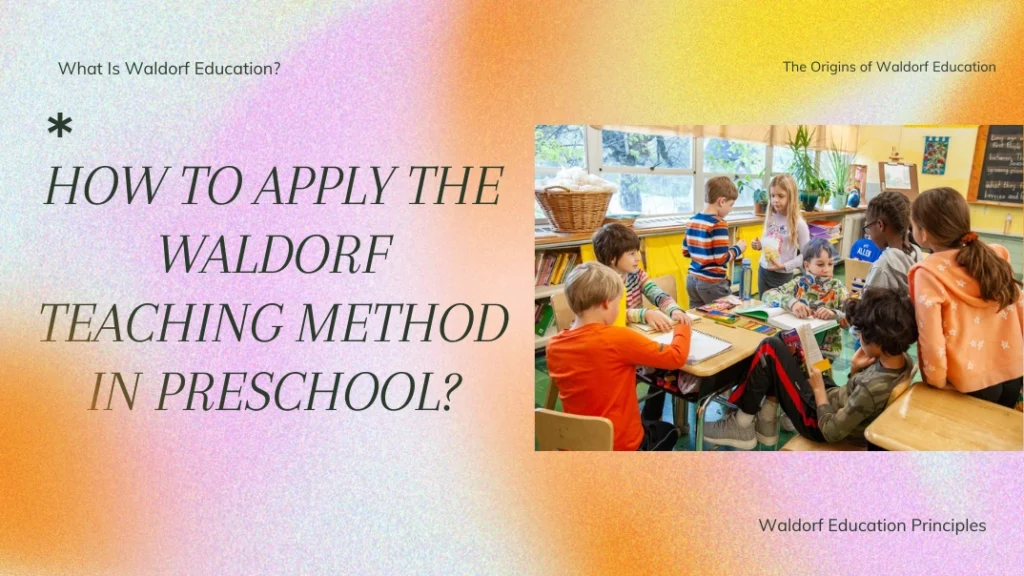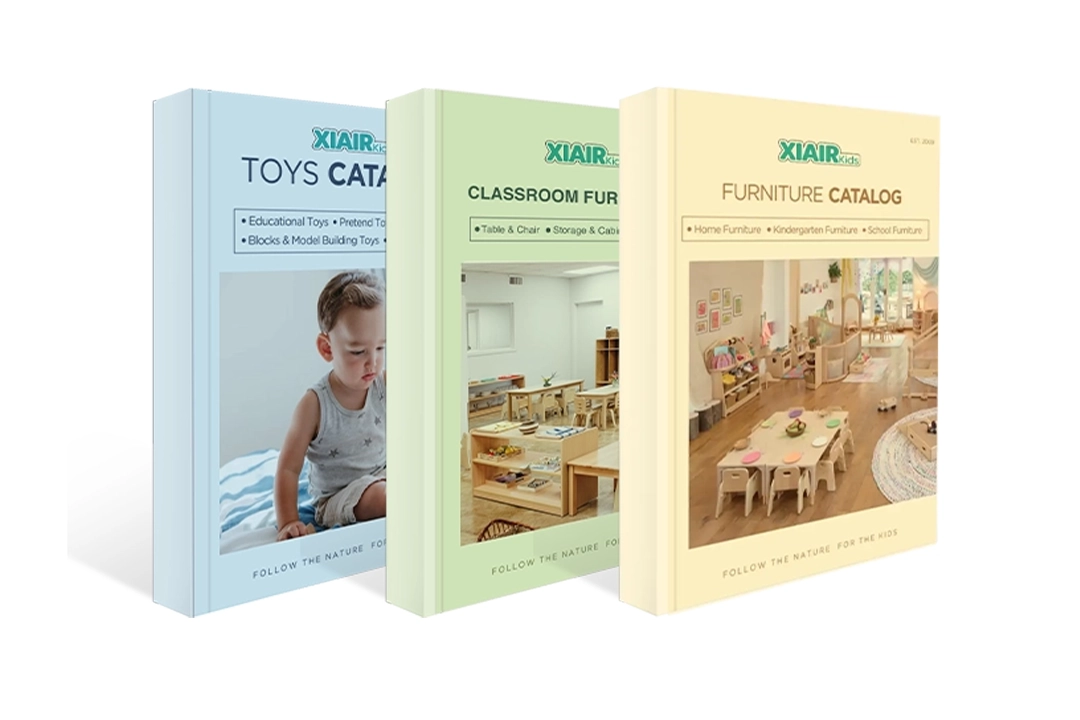O Método Waldorf de Ensino ganhou força considerável em todo o mundo, especialmente em ambientes pré-escolares, onde o desenvolvimento integral da criança é priorizado. Mas o que exatamente é... Educação WaldorfE como o currículo Waldorf pode ser implementado de forma eficaz em pré-escolas? Este método se destaca por seu foco único no desenvolvimento integral da criança — mente, corpo e espírito — e por sua ênfase na criatividade, independência e conexão com a natureza. Este artigo apresentará os princípios da educação Waldorf, seus prós e contras e como incorporar suas metodologias em sua sala de aula.
O Método de Ensino Waldorf, originário da filosofia educacional de Rudolf Steiner, prioriza a aprendizagem experiencial, fomentando a criatividade e uma relação profunda com a natureza. Ao incorporar a educação Waldorf na pré-escola, as crianças recebem preparação acadêmica e são nutridas para se tornarem pensadores criativos, indivíduos responsáveis e aprendizes ao longo da vida.
O Método de Ensino Waldorf se diferencia da educação tradicional por oferecer uma abordagem mais equilibrada e holística à aprendizagem infantil. Por meio da pedagogia Waldorf, as crianças vivenciam um ambiente rico de aprendizagem, abrangendo disciplinas acadêmicas, artes, habilidades práticas e desenvolvimento pessoal. No entanto, educadores e pais devem compreender que a implementação do Método de Ensino Waldorf exige um compromisso com seus princípios fundamentais.
Mas como o Método de Ensino Waldorf se diferencia dos modelos tradicionais e como pode ser integrado aos ambientes da primeira infância? Vamos começar explorando o que a educação Waldorf realmente é.
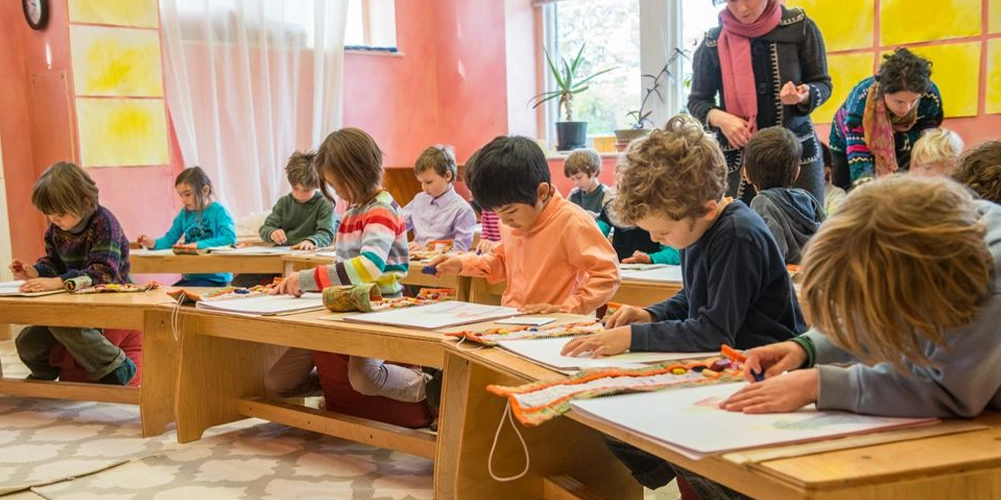
Introdução
O Método de Ensino Waldorf é conhecido por sua abordagem criativa e focada na criança. Baseada nas ideias de Rudolf Steiner, a educação Waldorf é praticada em escolas e jardins de infância em todo o mundo. Diferentemente das salas de aula tradicionais, as escolas Waldorf valorizam experiências práticas, um forte senso de ritmo e uma conexão próxima com a natureza. Essa forma única de ensinar inspirou muitos pais e professores a buscarem novas maneiras de apoiar o crescimento natural de cada criança e seu amor pelo aprendizado. Nas seções a seguir, exploraremos as principais ideias e princípios que tornam a abordagem Waldorf tão especial.
Método de Ensino Waldorf: Fundamentos e Princípios Essenciais
O Método de Ensino Waldorf acredita que as crianças aprendem melhor quando mente, corpo e emoções são apoiados em conjunto. Iniciada por Rudolf Steiner, essa abordagem considera cada criança como única, passando por diferentes estágios de crescimento. Nas salas de aula Waldorf, o aprendizado é prático e criativo, com bastante tempo para brincar, praticar arte e explorar a natureza. Um ritmo diário e sazonal constante ajuda as crianças a se sentirem seguras. Os professores respeitam o ritmo de cada criança e adaptam as aulas à turma. Essas ideias simples, porém poderosas, diferenciam o Método de Ensino Waldorf da educação tradicional.
Quem é Rudolf Steiner?
Rudolf Steiner foi um filósofo, reformador social e educador austríaco, mais conhecido por fundar o movimento da educação Waldorf. Steiner acreditava que a educação deveria nutrir cada parte da mente, do corpo e do espírito da criança. Suas ideias moldaram o que hoje é chamado de Método de Ensino Waldorf, ou educação Steiner, praticado em muitas escolas Waldorf ao redor do mundo. A filosofia de Steiner, conhecida como Antroposofia, está no cerne de todos os princípios da educação Waldorf.
Hoje, Steiner e a educação Waldorf estão intimamente ligadas. Muitos professores, pais e escolas Waldorf ainda estudam as palestras e os escritos de Steiner para compreender melhor as características únicas dessa abordagem. O sistema Waldorf incentiva a criatividade, a individualidade e um forte senso de conexão com o mundo — uma visão apresentada pela primeira vez por Rudolf Steiner há mais de um século.
Graças à influência de Steiner, as escolas Waldorf cresceram globalmente, incluindo os Estados Unidos, a Europa e a Ásia. A visão de educação de Rudolf Steiner, agora chamada de abordagem Steiner Waldorf, é conhecida por combinar disciplinas acadêmicas com artes, atividades práticas e respeito ao desenvolvimento infantil.
O que é a Pedagogia Waldorf?
A pedagogia Waldorf, às vezes chamada de Método de Ensino Waldorf ou pedagogia Steiner, é uma forma de ensino que se concentra na criança como um todo. Esse método é utilizado em escolas Waldorf, jardins de infância Waldorf e até mesmo em programas públicos de educação Waldorf. Em sua essência, a pedagogia Waldorf incentiva as crianças a aprenderem fazendo, com muitas brincadeiras, arte, música e atividades práticas.
A sala de aula Waldorf tem uma aparência e um toque diferentes das escolas tradicionais. Frequentemente, há brinquedos de madeira, materiais naturais e espaços criativos para as crianças explorarem. O currículo acompanha as fases naturais da infância e valoriza o ritmo de cada criança. Esse ambiente de aprendizagem único é uma das características definidoras da pedagogia Waldorf e o que diferencia o método Waldorf de outros sistemas educacionais.
As famílias são atraídas pela abordagem Waldorf porque ela enfatiza a imaginação, as habilidades práticas e o amor pelo aprendizado que perdura por toda a vida. A filosofia da educação Waldorf respeita a importância da rotina, do ritmo e de uma forte conexão entre a família e a escola. Hoje, existem milhares de escolas Waldorf e Steiner em todo o mundo, cada uma dedicada a ajudar crianças a se tornarem adultos atenciosos, confiantes e compassivos.
Não sonhe, projete! Vamos conversar sobre suas necessidades de móveis personalizados!
As origens da educação Waldorf
A primeira escola Waldorf foi fundada em 1919 para os filhos de operários da fábrica de cigarros Waldorf-Astoria, em Stuttgart, Alemanha. Rudolf Steiner idealizou um sistema educacional que desenvolvesse as habilidades intelectuais e as capacidades artísticas, práticas e morais dos alunos. O sistema educacional Waldorf foi projetado para ser dinâmico e flexível, permitindo aos professores a liberdade de criar aulas adaptadas aos estágios específicos de desenvolvimento de seus alunos. O objetivo era formar indivíduos completos, capazes de contribuir significativamente para a sociedade.
Desde então, a educação Waldorf e Steiner expandiu-se globalmente, com milhares de escolas Waldorf operando em todo o mundo. Cada escola Waldorf implementa o Método de Ensino Waldorf, adaptando os princípios de Steiner aos contextos culturais, geográficos e sociais de seus alunos. Seja em uma escola rural ou urbana, o currículo Waldorf concentra-se no desenvolvimento integral da criança por meio de atividades acadêmicas e não acadêmicas.
Hoje, as escolas de educação Waldorf abrangem vários continentes, oferecendo educação da pré-escola ao ensino médio. Essas escolas continuam a seguir os princípios estabelecidos por Rudolf Steiner, com foco no desenvolvimento integral de cada criança.

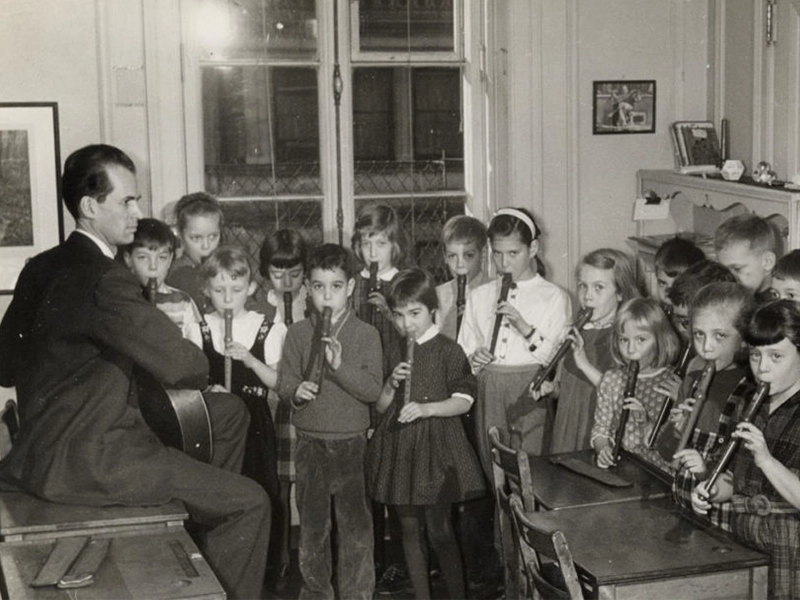
Os fundamentos da educação Waldorf
A educação Waldorf baseia-se na crença de que as crianças passam por três fases distintas de desenvolvimento: primeira infância, segunda infância e adolescência. Cada uma dessas fases é caracterizada por necessidades específicas de desenvolvimento, que são abordadas pelo currículo Waldorf de forma a apoiar o crescimento natural e a capacidade de aprendizagem da criança.
Primeira Infância
Durante a primeira infância, a educação Waldorf concentra-se na aprendizagem por meio de brincadeiras, imitação e experiências sensoriais. O ambiente da sala de aula Waldorf é intencionalmente simples e repleto de materiais naturais, como brinquedos de madeira e lã, que promovem a conexão com a natureza. Esta fase da educação Waldorf permite que as crianças desenvolvam seus corpos físicos e sentidos por meio de tarefas significativas como cozinhar, limpar e cuidar do jardim.
Aspectos críticos do currículo pré-escolar Waldorf incluem:
- Jogo Criativo:A aprendizagem baseada em brincadeiras é a base da pedagogia Waldorf nesta fase. As crianças são incentivadas a se envolver em brincadeiras imaginativas com brinquedos simples e naturais que inspiram a criatividade.
- Narrativa e Ritmo:Contar histórias, cantar canções e versos é fundamental nas atividades diárias, proporcionando uma estrutura rítmica que dá às crianças uma sensação de segurança.
- Habilidades práticas para a vida:As crianças participam de tarefas como assar pão, arrumar a sala de aula e plantar no jardim, o que ajuda a desenvolver habilidades motoras e promover a independência.
O Método de Ensino Waldorf enfatiza o desenvolvimento das capacidades físicas, emocionais e imaginativas das crianças durante esta fase. Por meio de tarefas práticas e brincadeiras, as crianças vivenciam o mundo e desenvolvem habilidades fundamentais que apoiam o aprendizado acadêmico futuro. A sala de aula Waldorf neste nível é propositalmente desprovida de dispositivos ou telas de alta tecnologia, o que se alinha à filosofia Waldorf de que as crianças devem se envolver mais diretamente com o ambiente ao seu redor.
Em uma pré-escola Waldorf, o professor desempenha um papel crucial na modelagem de comportamentos para as crianças imitarem. Isso destaca outro princípio fundamental do Método de Ensino Waldorf: as crianças aprendem melhor por meio do exemplo, não por meio de instruções diretas em um estágio tão inicial. As salas de aula Waldorf são frequentemente descritas como espaços serenos e acolhedores, que incentivam a brincadeira imaginativa e a exploração.
Infância Média
Nas escolas Waldorf, a aprendizagem intelectual começa a tomar forma na segunda infância. No entanto, em consonância com a filosofia de Steiner, o método de educação Waldorf ainda enfatiza a aprendizagem experiencial e a expressão artística como os principais veículos para o desenvolvimento intelectual.
Os principais elementos do currículo Waldorf para esta fase incluem:
- Blocos de Aula Principais: Matérias acadêmicas como matemática, literatura e ciências são ensinadas em blocos intensivos que duram várias semanas, permitindo que os alunos mergulhem totalmente no tópico.
- Integração Artística:Todas as matérias na sala de aula Waldorf são ensinadas por meio de métodos artísticos: desenho, pintura, contação de histórias e teatro são usados para tornar ideias complexas mais tangíveis e relacionáveis.
- Atividades Práticas: Seguindo a filosofia Waldorf, as crianças também se envolvem em tarefas práticas, como artesanato e marcenaria, que integram habilidades cognitivas e físicas.
Durante esta fase, a filosofia da escola Waldorf promove o desenvolvimento da inteligência emocional, enfatizando a criatividade, a imaginação e a colaboração.
O Método de Ensino Waldorf durante a segunda infância ajuda as crianças a se desenvolverem emocional e intelectualmente, preparando-as para as demandas acadêmicas mais rigorosas da adolescência. Os professores das escolas Waldorf são conhecidos por permanecerem com o mesmo grupo de alunos por vários anos, promovendo relacionamentos fortes e de confiança que contribuem para um ambiente de aprendizagem estável. Essa continuidade é uma característica crucial do sistema educacional Waldorf, diferenciando-o das escolas tradicionais, onde os alunos trocam de professor com frequência.
A educação Waldorf também enfatiza brincadeiras ao ar livre e a conexão com a natureza durante a infância. Atividades diárias ao ar livre, caminhadas na natureza e excursões são integradas ao currículo Waldorf para ajudar as crianças a se conectarem com o meio ambiente, refletindo ainda mais os valores fundamentais das escolas Waldorf.
Adolescência
À medida que as crianças entram na adolescência, o currículo Waldorf passa a promover o pensamento crítico, a reflexão ética e a responsabilidade social. As escolas Waldorf, nessa fase, enfatizam a aprendizagem independente, o engajamento comunitário e a busca por interesses pessoais.
Os principais aspectos desta fase incluem:
- Pensamento crítico:Os adolescentes são incentivados a se envolver em debates filosóficos, projetos de pesquisa e tarefas analíticas para desenvolver seu raciocínio e habilidades reflexivas.
- Aprendizagem de serviço: Seguindo os princípios Waldorf, os alunos participam de projetos de serviço comunitário que enfatizam a responsabilidade social e a consciência ética.
Nesta fase, o Método Waldorf de Ensino ajuda os adolescentes a compreenderem seu papel na comunidade e no mundo em geral. Os professores Waldorf se tornam mentores, apoiando os alunos no desenvolvimento da independência e de um forte senso de propósito.
Em Escolas WaldorfA adolescência é um período de autodescoberta e crescimento pessoal. O currículo é elaborado para desafiar os alunos intelectual e emocionalmente, orientando-os a se tornarem indivíduos empáticos e atenciosos, prontos para contribuir positivamente para a sociedade. As escolas de educação Waldorf em todo o mundo continuam implementando esses princípios para garantir que os alunos se formem com uma educação completa, que vai além do mero desempenho acadêmico.
Sua sala de aula perfeita está a um clique de distância!
Princípios da Educação Waldorf
A filosofia da educação Waldorf é definida por vários princípios fundamentais. Esses princípios orientam a forma como os professores interagem com os alunos e moldam o currículo para promover uma experiência de aprendizagem holística.
O Ser Humano como Ser Espiritual
Uma das crenças centrais da pedagogia Waldorf é que as crianças são seres espirituais com destinos únicos. O método de ensino Waldorf incentiva o desenvolvimento espiritual da criança, não em um sentido religioso, mas nutrindo um senso de admiração e reverência pela vida. As salas de aula Waldorf são projetadas para inspirar admiração por meio da beleza dos materiais naturais, dos ritmos sazonais e da expressão artística.
O Método de Ensino Waldorf está intimamente alinhado com os ritmos do mundo natural, com ritmos diários, semanais e sazonais ajudando a criar um ambiente previsível e seguro para crianças pequenas. Em uma pré-escola Waldorf, por exemplo, músicas, versos e atividades sazonais ajudam as crianças a se conectarem com o fluxo natural do tempo. O aspecto espiritual da educação Waldorf enfatiza o desenvolvimento do potencial único e do senso de identidade de cada criança, ajudando-as a se tornarem indivíduos empáticos e socialmente responsáveis.
Liberdade no Ensino
No sistema Waldorf, os professores têm considerável liberdade para ministrar aulas. O método de educação Waldorf permite que os educadores adaptem o currículo às necessidades e interesses de seus alunos, garantindo que a aprendizagem permaneça envolvente e relevante. Essa liberdade criativa distingue as escolas Waldorf dos sistemas educacionais tradicionais, onde currículos rígidos podem limitar experiências de aprendizagem individualizadas.
Os professores Waldorf têm autonomia para elaborar aulas que inspirem a curiosidade e a criatividade. Eles usam suas observações do desenvolvimento das crianças para orientar o conteúdo e os métodos de ensino. Essa liberdade permite que os professores das escolas Waldorf personalizem a experiência de aprendizagem de cada criança, tornando a educação um processo orgânico e evolutivo, em vez de algo padronizado.
O Método de Ensino Waldorf valoriza o papel do professor como educador e guia criativo, permitindo ambientes de aprendizagem dinâmicos e responsivos que incentivam os alunos a explorar seus interesses e talentos.
Aprendizagem experiencial e construção de relacionamentos
A educação Waldorf prioriza a aprendizagem experiencial, onde as crianças se envolvem com os assuntos por meio de atividades práticas. Seja pintando, cuidando do jardim ou contando histórias, os alunos em uma sala de aula Waldorf aprendem fazendo. Além disso, o relacionamento próximo entre professor e aluno é outra marca registrada da pedagogia Waldorf. Os professores frequentemente permanecem com o mesmo grupo de alunos por vários anos, promovendo conexões profundas que aprimoram a experiência de aprendizagem.
O Método de Ensino Waldorf dá grande importância aos relacionamentos que se formam em sala de aula. Ter o mesmo professor orientando os alunos ao longo de vários anos cria um forte vínculo de confiança e compreensão, criando um ambiente de apoio onde os alunos se sentem seguros para se expressar e assumir riscos em sua aprendizagem. Essa continuidade é essencial para o sistema educacional Waldorf, promovendo estabilidade e segurança emocional ao longo da jornada escolar da criança.
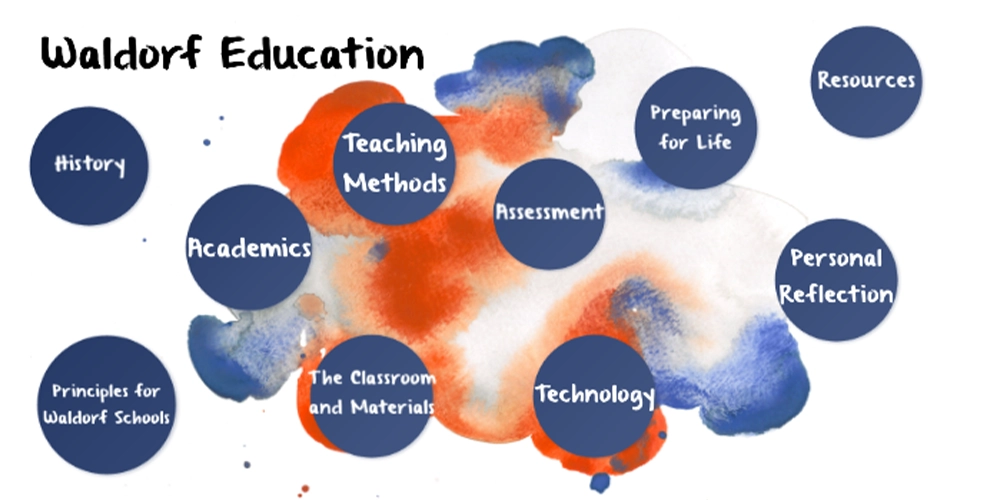
Prós e contras do método de ensino Waldorf
Ao considerar o sistema educacional Waldorf para ambientes pré-escolares, é essencial avaliar seus pontos fortes e potenciais desafios. Abaixo, uma análise abrangente dos prós e contras da abordagem Waldorf.
Prós:
- A aprendizagem é prática e adequada à idade
O método de ensino Waldorf enfatiza o aprendizado experimental e tátil, permitindo que as crianças se envolvam em atividades que correspondem ao seu estágio de desenvolvimento. - A aprendizagem é baseada em brincadeiras
A brincadeira é um aspecto vital da aprendizagem nas pré-escolas Waldorf, promovendo a criatividade, o desenvolvimento cognitivo e as habilidades sociais. - A tecnologia não é usada na sala de aula.
O modelo de educação Waldorf minimiza deliberadamente o uso da tecnologia, incentivando as crianças a se envolverem diretamente com o mundo ao seu redor. - Os alunos aprendem a ter um papel ativo na sua educação
O método Waldorf incentiva as crianças a serem aprendizes autodirigidos, promovendo independência e curiosidade. - As escolas Waldorf produzem indivíduos completos.
A abordagem holística da educação Waldorf apoia o desenvolvimento das capacidades intelectuais, emocionais e artísticas, ajudando as crianças a se tornarem indivíduos completos. - Indivíduos educados em Waldorf têm uma paixão vitalícia pelo aprendizado
Os formandos das escolas Waldorf geralmente mantêm um profundo amor pelo aprendizado ao longo da vida, pois a filosofia Waldorf instila curiosidade e um senso de admiração.
Contras:
- Falta de foco nos estudos
- Críticos da educação Waldorf argumentam que a introdução tardia de atividades acadêmicas formais, como leitura e matemática, pode colocar os alunos em desvantagem em comparação com seus colegas em ambientes tradicionais.
- Os professores ensinam as mesmas crianças por vários anos
- Embora isso promova relacionamentos fortes, pode limitar a exposição do aluno a diferentes estilos e perspectivas de ensino.
- Uso limitado de tecnologia
- Embora muitos pais apreciem a abordagem sem tecnologia da educação Waldorf, outros acham que ela pode deixar os alunos despreparados para um mundo movido pela tecnologia.
As escolas de educação Waldorf são frequentemente criticadas por sua relutância em incorporar a tecnologia em sala de aula. Embora o objetivo seja promover um engajamento pessoal e criativo mais profundo, alguns pais e educadores temem que as crianças nas escolas Waldorf possam não desenvolver as habilidades de alfabetização digital necessárias para o mundo moderno. Apesar disso, muitos defensores do Método de Ensino Waldorf argumentam que o foco na criatividade e nas habilidades de resolução de problemas nas escolas Waldorf prepara adequadamente os alunos para os desafios futuros.

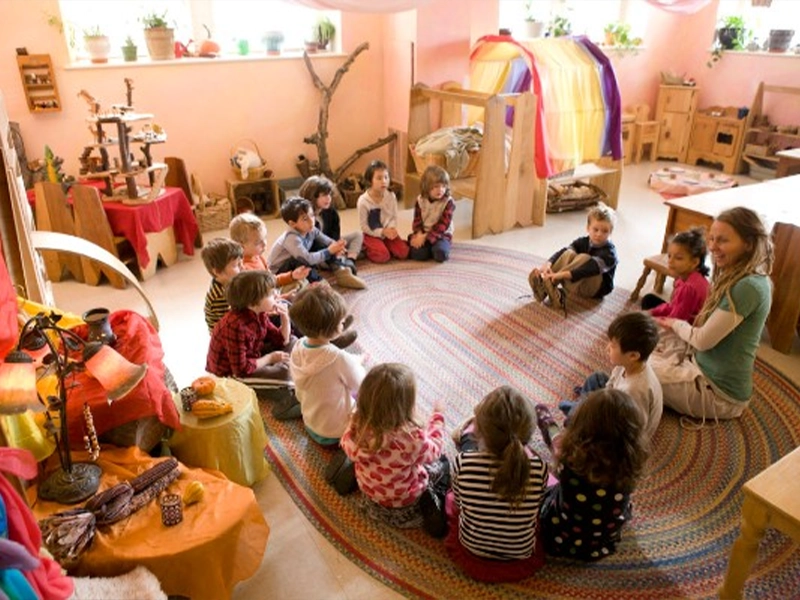
Criando um ambiente de aprendizagem inspirado em Waldorf
Uma sala de aula inspirada na filosofia Waldorf é cuidadosamente projetada para refletir a essência do Método de Ensino Waldorf. Cada detalhe — da cor das paredes à escolha dos móveis — desempenha um papel importante no apoio à aprendizagem e ao bem-estar das crianças. Vamos analisar os aspectos mais importantes para criar um espaço onde a educação Waldorf possa realmente prosperar.
Por que o ambiente da sala de aula é importante na educação Waldorf
No Método de Ensino Waldorf, o ambiente de sala de aula é vista como uma extensão do processo de aprendizagem. As escolas Waldorf entendem que as crianças absorvem mais do que apenas o que lhes é ensinado — elas são profundamente influenciadas pelo ambiente em que vivem todos os dias.
- A sala de aula como “terceiro professor”:
Na educação Waldorf, a sala de aula física não é apenas um pano de fundo, mas uma parte ativa da equipe pedagógica. O espaço guia suavemente o comportamento e a mentalidade das crianças. Quando uma sala de aula Waldorf é organizada com propósito, ela naturalmente promove o foco, a criatividade e a colaboração entre os alunos. É por isso que muitas escolas Waldorf investem em layouts cuidadosamente planejados, iluminação suave e áreas organizadas. - Espaços calmos e convidativos:
As salas de aula Waldorf evitam cores berrantes ou luzes fortes. Em vez disso, elas apresentam tons suaves, luz natural e muitos cantos tranquilos. Esse ambiente ajuda as crianças a se sentirem seguras e confortáveis, o que, por sua vez, as incentiva a explorar, fazer perguntas e experimentar coisas novas. Um ambiente tranquilo é uma marca registrada da educação Waldorf e está intimamente ligado ao sucesso da abordagem de ensino Waldorf. - Movimento e Flexibilidade:
Ao contrário das salas de aula tradicionais, uma sala de aula Waldorf não é fixa. Os móveis podem ser movidos para criar espaço para trabalho em grupo, roda de conversa ou brincadeiras imaginativas. Layouts flexíveis promovem independência e cooperação. As crianças são convidadas a participar da organização da sala de aula, o que ensina responsabilidade e respeito pelos espaços compartilhados — um valor fundamental nas escolas de educação Waldorf. - Conexão com os sentidos:
Cada elemento, da textura de um tapete de lã ao aroma de prateleiras de madeira, é escolhido para apoiar o desenvolvimento sensorial das crianças. O método de aprendizagem Waldorf incentiva os professores a usar materiais que convidam ao toque e à interação. Essas experiências sensoriais conectam as crianças ao momento presente e as ajudam a se sentirem conectadas ao ambiente. - Apoiando o currículo Waldorf:
Uma sala de aula cuidadosamente projetada complementa todas as partes do currículo Waldorf. Seja contando histórias em um cantinho aconchegante, pintando em uma mesa iluminada pelo sol ou reunindo-se para cantar canções matinais, o ambiente enriquece cada experiência de aprendizagem. O Método de Ensino Waldorf nos lembra que as crianças prosperam quando suas salas de aula são tão acolhedoras e inspiradoras quanto as próprias aulas.
Escolhendo os materiais e móveis certos para salas de aula Waldorf
Selecionando o mobília certa e os materiais são essenciais para criar uma sala de aula Waldorf autêntica. As escolhas que você fizer moldarão não apenas a aparência da escola, mas também a forma como as crianças aprendem e interagem no dia a dia.
- Materiais naturais no coração do design Waldorf:
Escolas e jardins de infância Waldorf preferem materiais naturais como madeira, lã e algodão para móveis e itens de sala de aula. Cadeiras de madeira maciça, mesas de tamanho infantil e prateleiras de madeira natural são escolhas comuns. Essas peças não são apenas duráveis e seguras, mas também ajudam as crianças a se conectarem com o mundo natural, um princípio fundamental da filosofia educacional Waldorf. Você também encontrará tapetes de lã, cortinas de algodão e cestos artesanais. - Móveis ergonômicos e de tamanho infantil:
O Método de Ensino Waldorf valoriza a independência, por isso os móveis são escolhidos pensando na criança. Procure mesas baixas, cadeiras pequenas de madeira, estantes abertas e cabideiros posicionados na altura da criança. O design ergonômico favorece uma boa postura e movimentos saudáveis, essenciais na pedagogia Waldorf. - Simplicidade e Versatilidade:
Nas salas de aula Waldorf, o mobiliário e os materiais são simples para incentivar a brincadeira aberta. Suportes de brinquedo (estruturas de madeira para pendurar sedas ou criar cenas imaginativas) podem se transformar em um teatro de fantoches, uma loja ou um cantinho de leitura. Cavaletes de arte, grandes cestos de vime para blocos e bancos empilháveis oferecem múltiplos usos e apoiam a abordagem de aprendizagem Waldorf. - Segurança e Sustentabilidade:
A segurança é sempre uma prioridade. As escolas de educação Waldorf selecionam móveis com bordas lisas, bases estáveis e acabamentos atóxicos. A produção sustentável também é essencial, alinhada aos princípios Waldorf de respeito ao meio ambiente. Considere produtos ecologicamente corretos. móveis de madeira, prateleiras de armazenamento de bambu ou produtos certificados pelo FSC para sua sala de aula. - Harmonia Estética:
Cada item em uma sala de aula Waldorf é escolhido para promover um senso de beleza e ordem. Cores coordenadas, tecidos macios e texturas naturais criam uma atmosfera tranquila. Você frequentemente verá tapetes de lã, almofadas de algodão e itens decorativos inspirados na natureza no espaço.
Lista de verificação de produtos para uma sala de aula Waldorf
| Tipo de produto | Descrição / Uso | Características Waldorf |
|---|---|---|
| Mesas de madeira de tamanho infantil | Para trabalho em grupo, refeições e atividades artísticas | Materiais naturais, design ergonômico |
| Cadeiras de madeira | Oferece suporte à postura adequada e à independência | Resistente, tamanho infantil, fácil de mover |
| Prateleiras/Estantes abertas | Armazenamento para livros, brinquedos e materiais de sala de aula | Altura baixa para fácil acesso, madeira natural |
| Teatros de Marionetes / Teatros de Bonecos | Para brincadeiras imaginativas e criação de cenas | Versátil, estimula a criatividade |
| Cavaletes de arte e mesas de artesanato | Pintura, desenho e artesanato | Ajustável, fácil de limpar |
| Grandes Cestas de Tecido | Organize blocos, brinquedos e materiais de arte | Fibras macias e naturais, uso flexível |
| Tapetes de lã ou algodão | Defina espaços de grupo e cantos de leitura | Textura macia, cores naturais |
| Almofadas de chão e pufes | Crie áreas de leitura ou descanso aconchegantes e convidativas | Materiais confortáveis e seguros |
| Mesas/Prateleiras de exposição da natureza | Mostrar itens sazonais e coleções de natureza | Conecta a sala de aula à natureza |
| Cabideiros na altura da criança | Promover a independência e a ordem | Altura adequada para autocuidado |
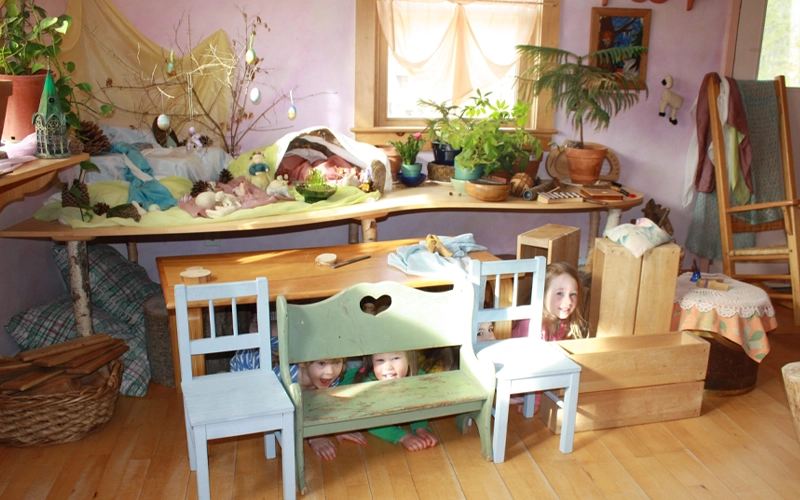
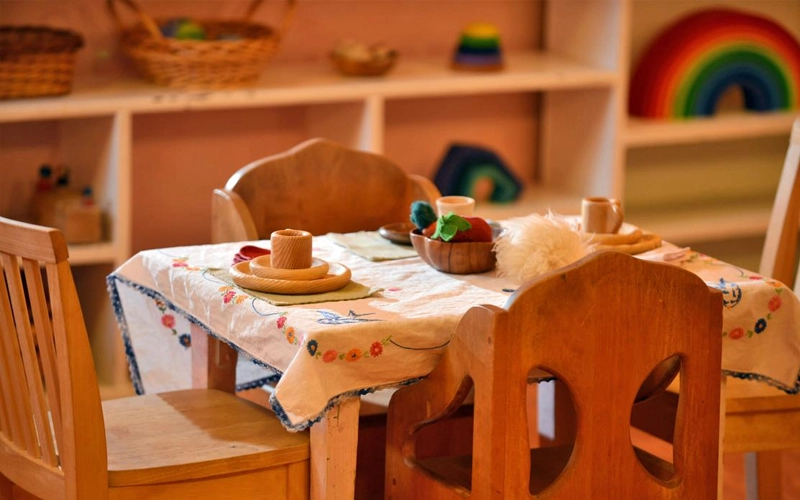
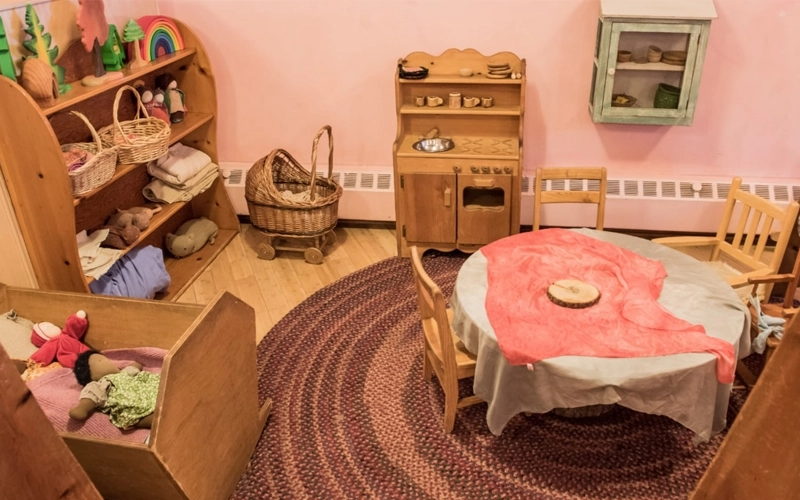
Projetando áreas de aprendizagem e brincadeiras abertas
Uma característica fundamental do Método de Ensino Waldorf é criar espaço para brincadeiras abertas e exploração prática. Nas salas de aula Waldorf, os professores utilizam layouts bem pensados e produtos versáteis para estimular a imaginação e o crescimento social.
- Espaços flexíveis para brincadeiras imaginativas:
As escolas Waldorf fazem ótimo uso de estandes de brinquedos, que podem se transformar em uma loja, um teatro ou um refúgio aconchegante com apenas alguns lenços de seda ou pedaços de tecido. Blocos de madeira, caixas empilháveis e mesas simples permitem que as crianças criem seus mundos de brincar. - Materiais simples e multiuso:
Os brinquedos e acessórios das salas de aula Waldorf são escolhidos por sua versatilidade. Bonecas Waldorf, animais de madeira, cestos de vime, tapetes de feltro e lenços de seda permitem que as crianças inventem suas próprias histórias, construam cenários e explorem o movimento. Isso reforça a filosofia Waldorf de aprender fazendo. - Sem telas ou brinquedos a pilhas:
Seguindo a pedagogia Waldorf, não há dispositivos eletrônicos na sala de aula. Em vez disso, as crianças se envolvem intensamente com quebra-cabeças de madeira, objetos inspirados na natureza e materiais de artesanato criativo. - Zonas para diferentes atividades:
Os espaços são preparados para uma variedade de usos: um canto de leitura com almofadas no chão e uma estante baixa, uma área de construção com fatias de árvores e cestos de peças soltas, uma mesa de arte com tintas e argila e um palco de fantoches para contar histórias. - Incentivando o crescimento social e emocional:
Com esses recursos abertos, as crianças aprendem naturalmente a cooperar, compartilhar e se comunicar, o que é uma marca registrada da educação Waldorf.
Produtos típicos de brincadeiras e aprendizagem Waldorf:
| Produto | Uso em sala de aula |
|---|---|
| Suportes de jogo | Construindo fortes, lojas, teatros de fantoches |
| Blocos de construção de madeira | Construção criativa, contagem e classificação |
| Lenços e tecidos de seda | Trajes, movimento, cenário para brincadeiras imaginativas |
| Bonecas e fantoches Waldorf | Contação de histórias, dramatização, aprendizagem social |
| Cestas de Tecido | Armazenar brinquedos, objetos naturais ou materiais de arte |
| Almofadas e tapetes de chão | Áreas aconchegantes para leitura, descanso ou roda de conversa |
| Cavaletes de arte e mesas de artesanato | Pintura, desenho, projetos colaborativos |
| Prateleiras baixas e estantes | Armazenamento acessível, exposição de livros para crianças |
| Fatias de árvores e partes soltas | Construindo, empilhando, exploração baseada na natureza |
Esses produtos abertos ajudam a dar vida ao Método de Ensino Waldorf, transformando qualquer sala de aula em um lugar onde a criatividade, a independência e a descoberta fazem parte da vida cotidiana.
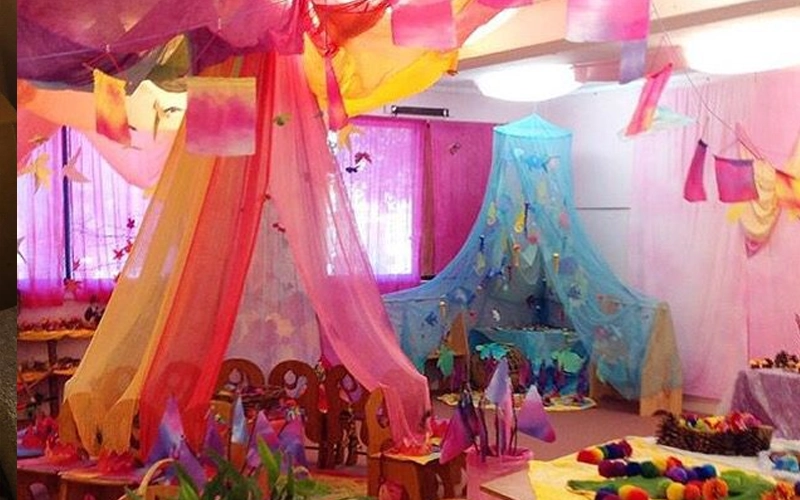
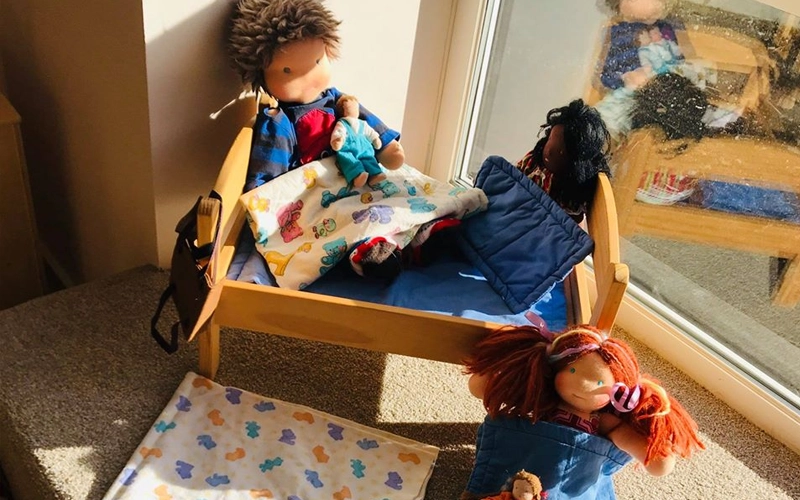

Trazendo a natureza e o ritmo sazonal para a sala de aula
O Método de Ensino Waldorf prioriza a conexão das crianças com a natureza e a valorização do ritmo das estações. Em uma sala de aula Waldorf, o ambiente é cuidadosamente projetado para refletir os ciclos do mundo natural, um aspecto fundamental da pedagogia e da filosofia Waldorf.
- Mesas da Natureza e Exibições Sazonais:
Nas escolas Waldorf e nas pré-escolas de educação Waldorf, uma mesa de natureza é um elemento central. As crianças coletam e exibem itens sazonais, como pedras, folhas e flores, transformando a sala de aula em um reflexo vivo das mudanças da natureza. Esta atividade prática é uma marca registrada do Método de Ensino Waldorf e apoia a abordagem de aprendizagem Waldorf, incentivando a observação e o respeito pela natureza. - Maximizando a luz natural e a vida vegetal:
Uma sala de aula Waldorf típica é repleta de luz solar e ar fresco, contribuindo para o bem-estar e a aprendizagem das crianças. Plantas e jardins internos são comuns em escolas de educação Waldorf, ajudando os alunos a aprender a cuidar dos seres vivos. Os professores em escolas Waldorf podem usar vitrais ou apanhadores de sol para trazer cores e beleza naturais ao espaço. - Artesanato sazonal e decorações naturais:
O currículo Waldorf inclui diversos trabalhos manuais com lã, feltro e madeira. As crianças criam decorações e projetos artísticos que celebram cada estação, como guirlandas de primavera ou móbiles de outono. Essa atividade criativa é fundamental para a metodologia Waldorf e ajuda a construir o ritmo da sala de aula Waldorf. - Aprendizagem ao ar livre e caminhadas na natureza:
A abordagem Waldorf incentiva o tempo regular ao ar livre, seja no jardim da escola ou em caminhadas na natureza. Essas experiências estão profundamente integradas ao sistema educacional Waldorf, ajudando as crianças a aprender por meio da experiência direta e reforçando os valores do Método de Ensino Waldorf. - Ritmos diários e semanais:
Professores que seguem a filosofia da educação Waldorf planejam rotinas e festivais sazonais em sincronia com os ritmos da natureza. Círculos matinais, bolos semanais e celebrações sazonais são exemplos clássicos do sistema Waldorf em ação.
Em cada sala de aula Waldorf, esses elementos e ritmos naturais dão vida à aprendizagem. O Método de Ensino Waldorf ensina as crianças a perceber o mundo ao seu redor e a se sentirem parte de algo maior — uma parte essencial das características únicas da educação Waldorf.
Sua sala de aula perfeita está a um clique de distância!
Apoiando a independência e a criatividade por meio do layout
Um dos principais objetivos do Método de Ensino Waldorf é ajudar as crianças a se tornarem pensadoras independentes e solucionadoras criativas de problemas. A forma como uma sala de aula Waldorf é organizada pode fazer uma grande diferença no apoio à independência e à criatividade de cada criança.
- Móveis e materiais acessíveis:
Nas escolas Waldorf, todas as mesas, cadeiras, prateleiras e armários de armazenamento são dispostos a uma altura adequada para as crianças. Isso incentiva as crianças a encontrar o que precisam, arrumar tudo após as atividades e fazer suas próprias escolhas ao longo do dia. A sala de aula Waldorf é projetada para empoderar as crianças e promover a autoconfiança, um princípio fundamental da filosofia educacional Waldorf. - Layouts abertos para livre circulação:
O Método de Ensino Waldorf recomenda plantas abertas com caminhos claros. Os móveis são dispostos de forma que as crianças possam se movimentar livremente entre as áreas de atividades, como áreas de recreação, cantos de leitura e mesas de arte. Essa liberdade estimula a exploração criativa, a colaboração e a coordenação motora, todas valorizadas na pedagogia Waldorf. - Escolha e flexibilidade:
A abordagem Waldorf permite que as crianças escolham onde e como trabalhar ou brincar. Ter múltiplos espaços — como um cantinho tranquilo para leitura, uma mesa grande para arte em grupo ou uma área aberta para construção — permite que os alunos sigam seus interesses e expressem sua individualidade. Isso reforça as características únicas do método de aprendizagem Waldorf. - Atividades autodirigidas:
Professores que utilizam o modelo de educação Waldorf incentivam projetos autoiniciados e tarefas abertas. Os materiais são expostos de forma organizada e convidativa para que as crianças possam iniciar as atividades sozinhas e guardá-las quando terminarem. Essa rotina ajuda os alunos a desenvolver responsabilidade e senso de pertencimento na sala de aula. - Incentivando a colaboração:
Embora a independência seja fundamental, o layout também estimula o trabalho em equipe. Assentos coletivos, materiais compartilhados e espaços abertos para rodas de conversa ou apresentações proporcionam aos alunos a oportunidade de trabalhar juntos, compartilhar ideias e resolver problemas coletivamente — um aspecto central do sistema educacional Waldorf.
Com um layout de sala de aula bem pensado, o Método de Ensino Waldorf cria um ambiente onde as crianças desenvolvem habilidades de vida, automotivação e confiança criativa — qualidades que perduram muito além dos anos pré-escolares.
Integrando áreas de aprendizagem ao ar livre
No Método de Ensino Waldorf, a aprendizagem não termina na porta da sala de aula. Os espaços ao ar livre são vistos como extensões vitais do ambiente escolar Waldorf, oferecendo às crianças ar fresco, movimento e infinitas oportunidades de se conectar com a natureza.
- Projete salas de aula ao ar livre com a natureza em mente
As escolas de educação Waldorf costumam criar áreas de jardim, caixas de areia ou recantos tranquilos ao ar livre. Use materiais naturais — como bancos de madeira, tocos de árvores para sentar ou cercas de bambu — para manter o espaço externo em harmonia com a filosofia Waldorf. - Planeje atividades sazonais
Reserve um tempo para caminhadas na natureza, jardinagem e celebrações sazonais. As crianças podem plantar bulbos na primavera, colher folhas no outono ou construir fortes de neve no inverno. O aprendizado ao ar livre promove o ritmo e as experiências sensoriais tão importantes na pedagogia Waldorf. - Forneça materiais de jogo abertos ao ar livre
Ofereça peças soltas, como troncos, pedras, galhos e cordas para construir e explorar. Evite equipamentos de plástico para playgrounds — elementos naturais combinam melhor com a abordagem Waldorf e estimulam a criatividade. - Crie espaços protegidos
Inclua uma área sombreada ou um abrigo externo simples para que as crianças possam aprender e brincar ao ar livre em qualquer clima. Quadros negros, mesas baixas e estações de arte natural acrescentam variedade às aulas ao ar livre. - Apoie a Exploração e a Independência
O aprendizado ao ar livre na educação Waldorf visa dar às crianças a liberdade de explorar. Limites seguros, professores visíveis e regras básicas simples permitem que as crianças assumam riscos e aprendam em seu próprio ritmo. - Amplie o currículo Waldorf para atividades ao ar livre
Muitas escolas Waldorf levam rotinas internas para o ambiente externo — rodas matinais, contação de histórias, pintura e até mesmo a hora do lanche podem acontecer ao ar livre. Essa extensão reforça as características únicas do Método de Ensino Waldorf.
A integração cuidadosa de áreas de aprendizagem ao ar livre ajudará as crianças a prosperar, apoiará o desenvolvimento integral da criança e realmente dará vida ao Método de Ensino Waldorf na sua escola ou pré-escola.
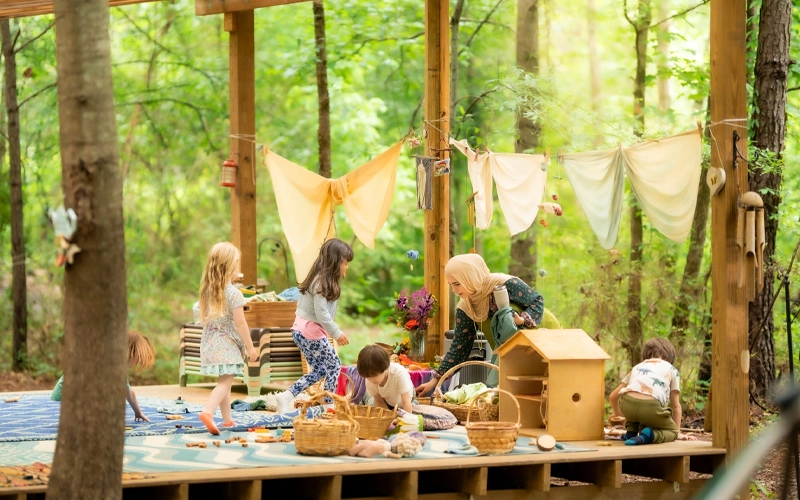
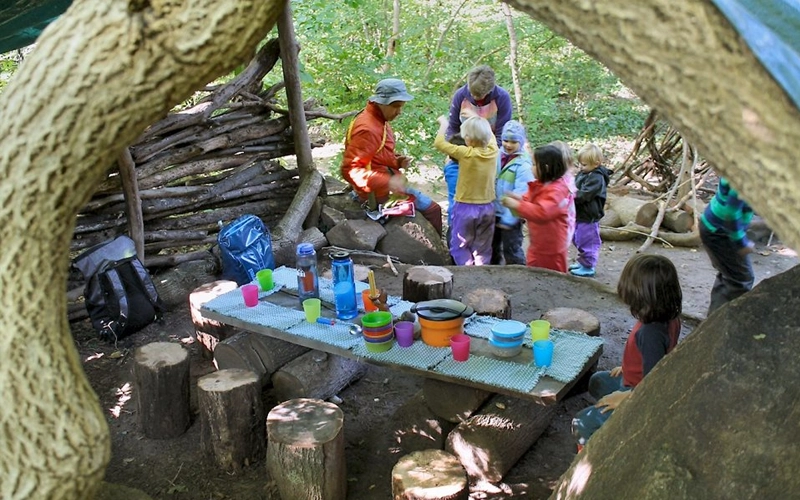
Dicas práticas para montar uma sala de aula inspirada no Waldorf
Montar uma sala de aula Waldorf exige mais do que apenas escolher belos móveis. O Método de Ensino Waldorf visa criar um ambiente que apoie o crescimento de cada criança — mente, corpo e espírito. Aqui estão algumas sugestões práticas para quem está preparando uma sala de aula ou pré-escola Waldorf:
- Comece com um plano claro:
Antes de trazer qualquer mobiliário, decida como a sala de aula Waldorf será usada ao longo do dia. Considere os ritmos diários e sazonais, as atividades em grupo, os cantos tranquilos e o espaço para circulação. A pedagogia Waldorf valoriza a flexibilidade e a fluidez. - Priorize materiais naturais:
Selecione mesas e cadeiras de madeira maciça, tapetes de algodão ou lã e cortinas de fibra natural. Esses materiais ajudam a tornar o ambiente escolar Waldorf calmo, acolhedor e saudável. Evite plástico ou metal sempre que possível para se manter fiel à filosofia educacional Waldorf. - Criar zonas definidas:
Use prateleiras e móveis para organizar a sala de aula em áreas para brincadeiras, artes, leitura e trabalho em grupo. No Método de Ensino Waldorf, ter áreas claras reforça as características únicas do método de aprendizagem Waldorf. - Mantenha a decoração simples e rítmica:
Evite desordem e decorações chamativas. Em vez disso, exiba artesanatos sazonais, mesas com elementos da natureza e cores suaves. A abordagem Waldorf acredita que o ritmo visual ajuda as crianças a se sentirem seguras e inspiradas. - Use móveis de tamanho infantil e armazenamento aberto:
Mesas baixas, cadeiras e prateleiras proporcionam independência às crianças. Elas conseguem alcançar os materiais sozinhas, o que é fundamental para as escolas de educação Waldorf e para a filosofia de ensino Waldorf. - Plano de Movimento:
Inclua espaço livre suficiente no chão para rodas de conversa, brincadeiras e atividades criativas. O método de educação Waldorf incentiva o movimento como parte das rotinas diárias. - Facilite a manutenção:
Escolha capas laváveis, móveis resistentes e cestos de armazenamento para manter a sala de aula organizada e limpa. O Método de Ensino Waldorf valoriza a beleza, mas deve ser prático para professores ocupados e crianças ativas. - Consulte fornecedores de móveis Waldorf:
Em caso de dúvida, entre em contato com fornecedores que entendam o sistema Waldorf e possam recomendar produtos que se encaixem na sua visão e no currículo Waldorf.
Montar uma sala de aula inspirada na filosofia Waldorf é um investimento no futuro de cada criança. Ao usar o Método de Ensino Waldorf para orientar suas escolhas, você cria um espaço onde as crianças podem prosperar, exatamente como Rudolf Steiner e as escolas Waldorf pretendiam.
Guia passo a passo: Configurando uma sala de aula Waldorf
Montar uma sala de aula Waldorf pode parecer desafiador no início, mas seguir um processo passo a passo simples torna a tarefa simples e eficaz. O Método de Ensino Waldorf enfatiza o planejamento cuidadoso, materiais naturais e flexibilidade. Aqui está um guia prático para ajudar você a criar uma sala de aula Waldorf acolhedora e inspiradora do zero:
Etapa 1: Defina o propósito da sala de aula e o ritmo diário
- Decida se o espaço será para uma pré-escola Waldorf, jardim de infância ou turma do ensino fundamental.
- Esboce seu ritmo diário e semanal, incluindo tempo para brincadeiras livres, roda de conversa, arte, contação de histórias e atividades ao ar livre.
- A filosofia da educação Waldorf valoriza rotinas e transições que ajudam as crianças a se sentirem seguras.
Etapa 2: Escolha um espaço calmo e iluminado
- Sempre que possível, selecione um cômodo com luz natural e bom fluxo de ar.
- Cores suaves nas paredes e cortinas simples nas janelas reforçam a atmosfera acolhedora da sala de aula Waldorf.
- Disponha os móveis de modo a aproveitar a luz natural e considere adicionar plantas ou cristais nas janelas.
Etapa 3: Selecione móveis naturais e de tamanho infantil
- Invista em mesas de madeira maciça, cadeiras de tamanho infantil, prateleiras abertas e cestos de armazenamento.
- Mantenha os caminhos desobstruídos e certifique-se de que cada criança consiga alcançar os materiais de forma independente, seguindo a pedagogia Waldorf e apoiando a independência.
- Coloque cantos de leitura, mesas de arte e mesas de natureza onde as crianças se reúnam naturalmente.
Etapa 4: Organize as zonas de atividades
- Use prateleiras ou tapetes para definir zonas para construção, leitura, arte, música e brincadeiras imaginativas.
- Torne cada área flexível para que ela possa mudar conforme os interesses das crianças e as necessidades da sala de aula.
- O método de aprendizagem Waldorf incentiva a variedade: não sobrecarregue, mas deixe espaço para movimento e descoberta.
Etapa 5: adicione materiais de jogo abertos e decorações sazonais
- Inclua suportes para brincar, blocos de madeira, lenços de seda, bonecas Waldorf e materiais de artesanato.
- Gire os materiais e atualize as tabelas de natureza ou exibições sazonais ao longo do ano para refletir as mudanças na natureza.
- A abordagem Waldorf valoriza a beleza e o ritmo, então exiba trabalhos artísticos infantis e decorações feitas à mão.
Etapa 6: Mantenha um espaço limpo e organizado
- Ensine as crianças a cuidar da sala de aula guardando as coisas após o uso.
- Use cestos, bandejas e prateleiras etiquetadas para facilitar o acesso e a limpeza.
- Um ambiente organizado reforça as características únicas da sala de aula Waldorf e do Método de Ensino Waldorf.
Etapa 7: Crie uma entrada acolhedora e comunique-se com as famílias
- Crie uma entrada amigável com um cabideiro, uma prateleira para sapatos e um espaço para comunicação dos pais.
- Exiba uma programação diária, próximos eventos e notícias sazonais para as famílias verem.
- O sistema educacional Waldorf incentiva fortes parcerias entre escola e família.
Dicas rápidas:
- Comece de forma simples e desenvolva conforme avança — cada sala de aula Waldorf evolui.
- Envolva professores, crianças e pais na decoração e manutenção do espaço.
- Entre em contato com os fornecedores de móveis Waldorf para obter soluções personalizadas que atendam às suas necessidades.
Com um planejamento cuidadoso e uma mente aberta, qualquer pessoa pode usar o Método de Ensino Waldorf para criar uma sala de aula onde as crianças se sintam inspiradas, valorizadas e prontas para aprender todos os dias.
Não sonhe, projete! Vamos conversar sobre suas necessidades de móveis personalizados!
Erros comuns a evitar na configuração da sala de aula Waldorf
Montar uma sala de aula Waldorf pode ser emocionante e desafiador. O Método de Ensino Waldorf é único e até mesmo professores experientes ou diretores escolares podem cometer erros se forem novos na educação Waldorf. Aqui estão algumas das armadilhas mais comuns a serem evitadas:
- Usando muitos materiais comerciais ou plásticos
Um dos maiores erros nas escolas Waldorf é encher a sala de aula com brinquedos de plástico coloridos e produtos comerciais. A filosofia Waldorf valoriza materiais naturais e simples que despertam a imaginação. Escolha sempre madeira, algodão, lã e outras fibras naturais para os móveis da sala de aula e materiais didáticos. - Superlotação do espaço
Tentar encaixar muitos móveis ou brinquedos pode fazer com que a sala de aula pareça desorganizada e sobrecarregada. A abordagem Waldorf acredita que "menos é mais". Mantenha espaços abertos para circulação e brincadeiras livres e faça rodízio de brinquedos e materiais ao longo do ano, em vez de expor tudo de uma vez. - Ignorando o ritmo e a rotina
As salas de aula Waldorf precisam de um ritmo constante para ajudar as crianças a se sentirem seguras e focadas. Pular rotinas diárias ou sazonais pode deixar os alunos ansiosos e atrapalhar o método de aprendizagem Waldorf. Planeje momentos regulares de roda, contação de histórias, artesanatos sazonais e transições. - Esquecendo a importância da natureza
Outro erro comum é não trazer o mundo natural para a sala de aula. Uma sala de aula Waldorf deve refletir as estações do ano, com mesas, plantas e decorações sazonais como elementos centrais do Método de Ensino Waldorf. - Negligenciar o conforto do professor e do aluno
Não negligencie o conforto dos professores e das crianças. Móveis em tamanho infantil, iluminação suave e áreas de leitura aconchegantes fazem com que todos se sintam em casa, o que é essencial para a filosofia da educação Waldorf. - Pular consulta com especialistas
Às vezes, as escolas tentam montar um ambiente Waldorf "faça você mesmo" sem consultar pessoas familiarizadas com a pedagogia Waldorf. Isso pode levar a escolhas de layout inadequadas ou à compra de produtos inadequados. Sempre que possível, trabalhe com fornecedores e educadores experientes em mobiliário Waldorf. - Falta de flexibilidade
A rigidez excessiva na disposição da sala ou o excesso de planejamento podem limitar a criatividade e o fluxo natural. A sala de aula Waldorf deve evoluir conforme as crianças crescem e mudam — esteja pronto para adaptar sua configuração conforme necessário.
Evitar esses erros ajuda a garantir que sua sala de aula Waldorf seja um ambiente acolhedor, criativo e estimulante que realmente apoia o Método de Ensino Waldorf.
Como incorporar o currículo Waldorf ao seu programa pré-escolar?
Se você está pensando em introduzir o método de educação Waldorf na sua pré-escola, há vários passos essenciais a seguir para se alinhar aos princípios da pedagogia Waldorf.
Crie uma programação consistente
As salas de aula Waldorf são conhecidas por seus horários estruturados, porém flexíveis. Um ritmo diário previsível proporciona às crianças uma sensação de segurança e as ajuda a transitar suavemente entre as atividades. Atividades em círculo, contação de histórias e atividades práticas como confeitaria ou jardinagem devem ser integradas ao dia para criar uma experiência de aprendizagem equilibrada e envolvente.
O Método de Ensino Waldorf dá grande ênfase ao ritmo e à rotina. Em uma pré-escola Waldorf, as crianças seguem uma rotina previsível e consistente que inclui tempo para brincadeiras criativas, tarefas práticas, atividades artísticas e reflexão silenciosa. Esse ritmo ajuda as crianças a se sentirem seguras e centradas, proporcionando uma base sólida de aprendizagem e crescimento pessoal.
Adicione brinquedos e móveis naturais
A filosofia de ensino Waldorf dá grande ênfase ao uso de materiais naturais. As salas de aula Waldorf são repletas de móveis de madeira, bonecas artesanais e fibras naturais, como lã e algodão. A simplicidade desses materiais ajuda a reduzir a superestimulação e incentiva as crianças a se envolverem mais profundamente em brincadeiras criativas.
Em uma pré-escola Waldorf, o ambiente é vital para o processo de aprendizagem. O currículo Waldorf recomenda o uso de brinquedos feitos de materiais naturais, que sejam táteis, simples e abertos, permitindo que as crianças explorem e usem a imaginação livremente. Evite brinquedos de plástico ou comerciais que possam ditar como devem ser usados. Em vez disso, use brinquedos que permitam que as crianças se envolvam em brincadeiras de faz de conta, contação de histórias e colaboração entre colegas.
Incentive habilidades práticas para a vida
Incorporar habilidades para a vida, como cozinhar, limpar e fazer artesanato, ao currículo Waldorf permite que as crianças desenvolvam responsabilidade, independência e coordenação motora fina. Essas atividades não são apenas tarefas domésticas — são experiências de aprendizagem que promovem um senso de realização e comunidade.
O Método de Ensino Waldorf considera essas tarefas práticas essenciais para o desenvolvimento da criança. Em uma sala de aula Waldorf, as crianças podem ajudar a preparar lanches, organizar a sala para as atividades do dia ou ajudar a arrumar a casa após o recreio. Essas atividades ensinam habilidades essenciais para a vida, promovem o trabalho em equipe e dão às crianças um senso de responsabilidade e pertencimento à comunidade escolar.
Explore a natureza com as crianças
Brincar ao ar livre é fundamental para a filosofia da educação Waldorf. Seja uma caminhada na natureza, jardinagem ou brincadeiras livres em um ambiente natural, essas atividades ajudam as crianças a construir uma conexão com a natureza, um componente essencial da educação Waldorf. A exposição regular à natureza promove um senso de admiração, curiosidade e responsabilidade ambiental.
Uma pré-escola Waldorf frequentemente incorpora atividades sazonais que refletem os ritmos do mundo natural, como plantar sementes na primavera, coletar folhas no outono ou construir esculturas de neve no inverno. Essas atividades ao ar livre incentivam a atividade física e aprofundam a apreciação das crianças pelo mundo ao seu redor. O mundo natural é visto como a melhor sala de aula na educação Waldorf, oferecendo infinitas oportunidades de exploração e aprendizado.
Qual a diferença entre a escola Waldorf e a escola regular?
A educação Waldorf se diferencia do ensino tradicional em vários aspectos importantes, principalmente na abordagem desenvolvimentista, na metodologia de aprendizagem e na filosofia geral. Veja como as escolas Waldorf se diferenciam das escolas regulares:
- O método Waldorf pode ser adaptado para salas de aula modernas?
O método de educação Waldorf desencoraja o uso da tecnologia, enquanto as salas de aula modernas frequentemente dependem fortemente de ferramentas digitais. Adaptar os princípios Waldorf para atender às demandas do cenário educacional atual é um desafio que muitas escolas enfrentam. - O método Waldorf é adequado para todos os tipos de crianças?
Embora o método Waldorf seja holístico e centrado na criança, ele pode não funcionar para todas as crianças, especialmente aquelas que prosperam em um ambiente acadêmico mais estruturado. - Como o método Waldorf aborda as diferenças individuais de aprendizagem?
O sistema educacional Waldorf permite que as crianças aprendam em seu próprio ritmo, promovendo a inclusão. No entanto, a falta de avaliações padronizadas pode não oferecer suporte suficiente para crianças com necessidades específicas de aprendizagem.
As escolas Waldorf costumam atrair famílias que priorizam a criatividade, o desenvolvimento emocional e um ritmo mais lento de introdução acadêmica. No entanto, alguns críticos argumentam que as crianças nas escolas Waldorf podem não estar tão bem preparadas para os testes padronizados e o rigor acadêmico do ensino tradicional. O sistema educacional Waldorf é projetado para atender às necessidades de cada criança, mas pode não corresponder às expectativas das famílias que buscam uma educação mais tradicional e estruturada.
Conclusão
Incorporar o Método de Ensino Waldorf na sua pré-escola pode levar a uma experiência educacional transformadora, na qual as crianças crescem emocional, intelectual e socialmente. O método Waldorf incentiva a criatividade, a independência e o amor eterno pelo aprendizado, com foco na aprendizagem prática e experiencial, além de promover a conexão com a natureza.
Ao adotar a filosofia Waldorf, você pode criar um ambiente acolhedor onde as crianças prosperam academicamente e em todas as áreas da vida. As características únicas da educação Waldorf oferecem uma alternativa holística e centrada na criança à educação tradicional, cultivando indivíduos completos e curiosos, prontos para enfrentar os desafios futuros. O sistema educacional Waldorf é ideal para promover experiências de aprendizagem profundas e significativas que duram a vida toda, tornando o Método de Ensino Waldorf uma excelente escolha para ambientes pré-escolares que buscam oferecer algo além do convencional.
Ao adotar o Método de Ensino Waldorf e alinhar seu programa pré-escolar aos seus princípios fundamentais, você pode criar um ambiente de aprendizagem rico e envolvente que apoia o desenvolvimento integral de cada criança. Este método garante que as crianças estejam preparadas para a escola e para a vida.
Perguntas frequentes
Qual é o principal diferencial de uma escola Waldorf?
Uma escola Waldorf segue o Método de Ensino Waldorf, com foco no desenvolvimento integral da criança por meio da arte, da imaginação e de atividades baseadas na natureza, em vez de exercícios acadêmicos iniciais. Essa abordagem única a diferencia dos modelos educacionais tradicionais.
Por que os materiais naturais são essenciais?
A educação Waldorf valoriza a madeira, a lã, o algodão e outros elementos naturais. Esses materiais ricos em sensações criam salas de aula tranquilas, alinhadas aos valores fundamentais da abordagem Waldorf e que promovem o bem-estar emocional das crianças.
Quando as crianças começam a aprender atividades acadêmicas formais?
No currículo Waldorf, a leitura e a escrita formais são introduzidas por volta dos 7 anos de idade. Antes disso, as crianças se envolvem em contação de histórias, artesanato e brincadeiras rítmicas, estabelecendo uma base sólida sem pressão acadêmica precoce.
As salas de aula Waldorf incluem tempo ao ar livre?
Sim — o aprendizado ao ar livre é uma constante nas escolas Waldorf. As atividades incluem jardinagem, caminhadas na natureza e festivais sazonais, estendendo a pedagogia Waldorf para além das paredes da sala de aula.
Como o layout pode dar suporte à independência?
Um layout bem projetado inclui prateleiras na altura das crianças, áreas de recreação abertas e assentos flexíveis. Isso permite que as crianças acessem os materiais, colaborem e se autogerenciem — características essenciais da filosofia da educação Waldorf.
Como evito superlotação em uma sala de aula Waldorf?
Opte por móveis simples e abertos, como mesas de madeira e prateleiras abertas, faça a rotação dos materiais ao longo do tempo e deixe espaço suficiente para movimentação. Este design minimalista "menos é mais" honra a metodologia Waldorf e estimula a criatividade.

